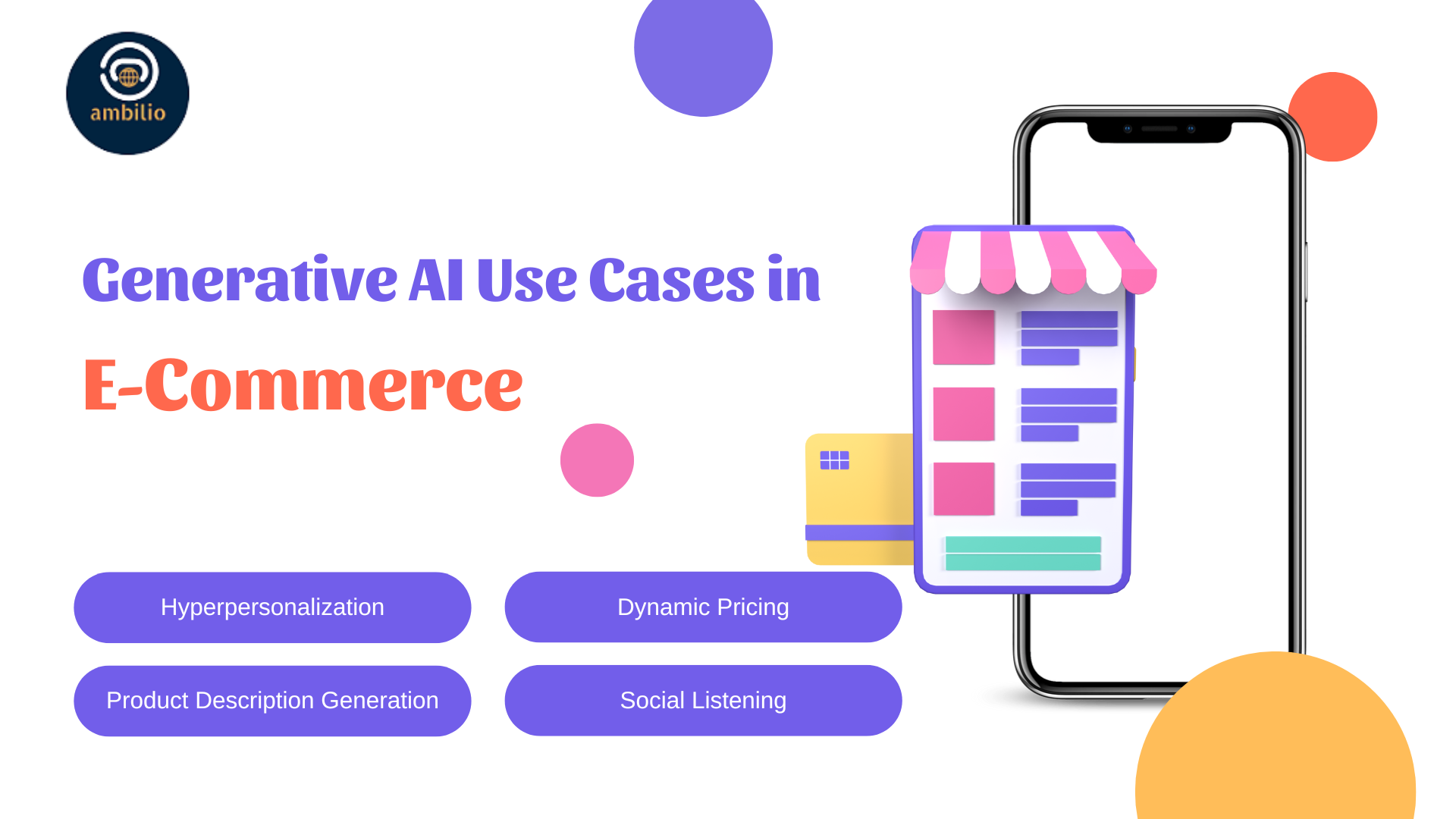E-commerce has experienced unprecedented growth over the last decade, driven by the increasing adoption of online shopping and the availability of new technologies that enable businesses to reach a broader audience. In this rapidly evolving landscape, businesses that can leverage the latest AI techniques to improve customer engagement, increase conversion rates, and enhance brand loyalty are poised to succeed.
One of the most promising AI techniques in e-commerce is generative AI, which includes models like GPT (Generative Pre-Trained Transformer) and LDM (Latent Diffusion Model). These models can be used for a variety of advanced applications, from hyper-personalization to social listening and sentiment analysis. We present here, the 4 cutting-edge use cases of Generative AI based on GPT and LDM in e-commerce, highlighting the problems they can solve, the steps involved in implementing them, and the benefits they can provide.
1. Hyper-personalization
Problem
With the rise of online shopping, customers have come to expect a highly personalized experience tailored to their individual preferences and needs. However, many businesses struggle to deliver this level of personalization at scale, leading to missed opportunities for sales and customer loyalty.
Solution
Hyper-personalization using GPT and LDM can help businesses deliver highly tailored shopping experiences that meet each customer’s unique needs and preferences. Here are the steps involved in implementing hyper-personalization:
Step 1: Collect Customer Data – Collect customer data from various sources such as transaction history, browsing history, social media, and surveys. This data should include details such as demographics, preferences, purchase behaviour, and past interactions with the brand.
Step 2: Train GPT Model – Use the collected data to train a GPT model to generate personalized product recommendations, content, and messaging based on customer preferences and behaviour.
Step 3: Analyze Data Using LDM – Use LDM to analyze customer data and identify patterns and correlations between customer behaviour, preferences, and product features. This information can be used to further personalize product recommendations and marketing messaging.
Step 4: Implement Personalization – Use the GPT model and LDM insights to personalize the shopping experience for each customer. This can include personalized product recommendations, targeted marketing messages, and customized landing pages.
Requirements
To implement hyper-personalization using GPT and LDM, businesses will need access to large amounts of customer data, as well as the necessary computing resources and AI tools to train and deploy GPT and LDM models.
Benefits
Hyper-personalization can help businesses increase customer loyalty, improve customer satisfaction, and drive more sales by providing a tailored shopping experience that meets each customer’s unique needs and preferences.
2. Dynamic Pricing
Problem
Setting prices for products can be a complex and challenging task, with many factors to consider, including demand, competition, and supply chain costs. Pricing strategies that are not optimized can result in missed revenue opportunities and reduced profits.
Solution
Dynamic pricing using GPT and LDM can help businesses optimize their pricing strategies in real-time based on a range of factors, including demand, competition, and other relevant variables. Here are the steps involved in implementing dynamic pricing:
Step 1: Collect Sales and Market Data – Collect sales and market data from various sources, including historical sales data, competitor pricing data, and other relevant variables such as seasonality, promotional activity, and consumer sentiment.
Step 2: Train GPT Model – Use the collected data to train a GPT model to predict optimal pricing strategies for different products, taking into account a range of factors such as demand, competition, and supply chain costs.
Step 3: Analyze Data Using LDM – Use LDM to simulate the impact of different pricing scenarios on customer behaviour and sales revenue, allowing businesses to identify the optimal pricing strategy for each product.
Step 4: Implement Dynamic Pricing – Use the GPT model and LDM insights to dynamically adjust prices in real-time based on changing market conditions and customer behaviour.
Requirements
To implement dynamic pricing using GPT and LDM, businesses will need access to large amounts of sales and market data, as well as the necessary computing resources and AI tools to train and deploy GPT and LDM models.
Benefits
Dynamic pricing can help businesses increase revenue, maximize profits, and remain competitive in a fast-changing market by optimizing their pricing strategies in real-time based on market conditions and customer behaviour.
3. Product Description Generation
Problem
Traditional product descriptions often fail to provide enough detail and context to help customers make informed purchase decisions. This can result in lower conversion rates and decreased customer satisfaction.
Solution
Product description generation using GPT can help businesses generate high-quality product descriptions that are both informative and engaging. Here are the steps involved in implementing product description generation using GPT:
Step 1: Collect Product Data – Collect product data such as product features, specifications, and user reviews.
Step 2: Train GPT Model – Use the collected product data to train a GPT model to generate high-quality product descriptions that are informative and engaging.
Step 3: Edit and Review Generated Descriptions – Review and edit the generated descriptions to ensure that they are accurate, informative, and meet the brand’s tone and style.
Step 4: Implement Generated Descriptions – Use the generated product descriptions on the product page to provide customers with detailed information about the product.
Requirements
To implement product description generation using GPT, businesses will need access to product data, as well as the necessary computing resources and AI tools to train and deploy GPT models.
Benefits
Product description generation using GPT can help businesses improve conversion rates and increase customer satisfaction by providing informative and engaging product descriptions that help customers make informed purchase decisions.
4. Social Listening and Sentiment Analysis
Problem
Social media is an essential channel for businesses to engage with customers and build brand awareness. However, it can be challenging to monitor and respond to customer feedback and sentiment across multiple social media platforms.
Solution
Social listening and sentiment analysis using LDM can help businesses monitor and analyze customer feedback and sentiment across multiple social media platforms in real-time. Here are the steps involved in implementing social listening and sentiment analysis using LDM:
Step 1: Collect Social Media Data – Collect social media data from various platforms such as Facebook, Twitter, and Instagram.
Step 2: Analyze Data Using LDM – Use LDM to analyze social media data and identify patterns and correlations between customer behaviour, sentiment, and other relevant variables.
Step 3: Respond to Customer Feedback – Use the insights gained from social listening and sentiment analysis to respond to customer feedback in real-time, addressing any issues or concerns that customers may have.
Step 4: Improve Marketing and Customer Service – Use the insights gained from social listening and sentiment analysis to improve marketing messaging and customer service, ensuring that customers’ needs and concerns are addressed.
Requirements
To implement social listening and sentiment analysis using LDM, businesses will need access to social media data, as well as the necessary computing resources and AI tools to analyze and interpret the data.
Benefits
Social listening and sentiment analysis using LDM can help businesses improve customer satisfaction, build brand loyalty, and enhance marketing messaging by providing real-time insights into customer feedback and sentiment across multiple social media platforms.
In conclusion, generative AI applications have immense potential to transform the e-commerce industry. By leveraging technologies such as natural language processing, machine learning, and deep learning, businesses can provide hyper-personalized experiences, optimize pricing, and generate product descriptions that resonate with customers. Furthermore, with the ability to listen and analyze social media sentiment, businesses can stay ahead of the curve and respond to customer feedback proactively. As a result, these AI applications can lead to enhanced customer experiences, increased revenues, improved operational efficiencies, and a stronger brand reputation.



